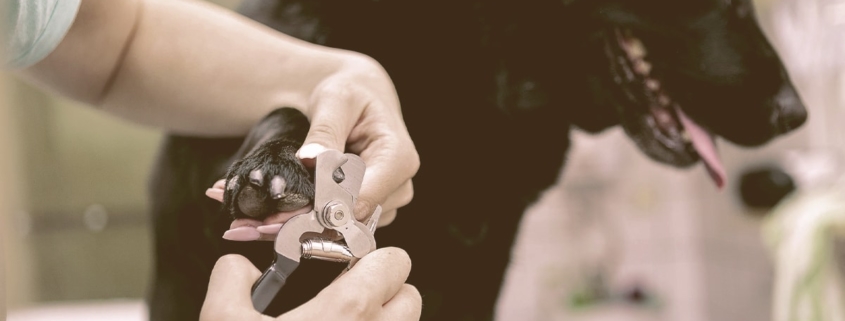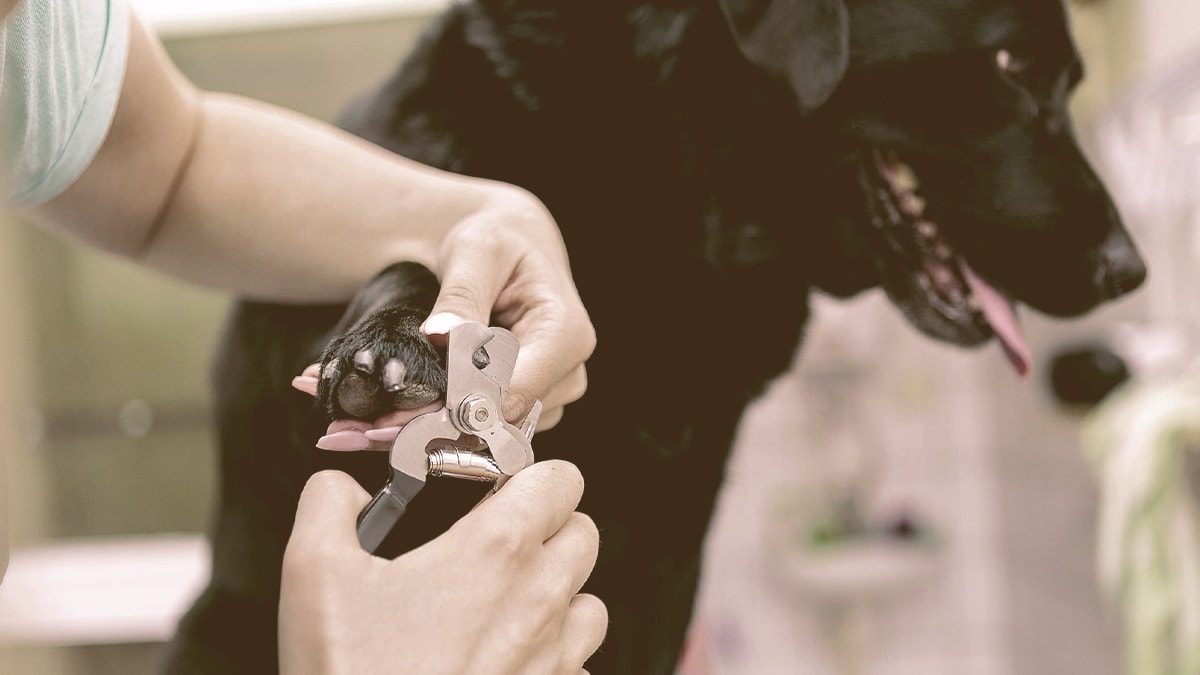
A Guide To Nail Clipping A Large Dog
Alex Vicente • Updated on August 22, 2023
- This review contains affiliate links. Read more here.
- Not a substitute for professional veterinary help.
Nail clipping a large dog is not always going to be an easy task. Some dogs hate getting their nails clipped. It doesn’t matter the reason, whether they have had a bad experience or are just skittish.
Many dogs fear the unknown, and it can end up being an incredibly stressful time for everyone involved.
It can be very hard for many pet owners with large and timid dogs.
If a large dog doesn’t want to do something, it won’t; and it’s as simple as that. It could become dangerous for both of you if the dog were to get spooked or fight while getting its nails clipped.
In this article, you will learn how to clip your dog’s nails the right way and some different methods to handle a large dog when clipping its nails.
Read on to have a better experience for you and your pet.
Table of Contents
Steps To Clipping A Large Dog’s Nails
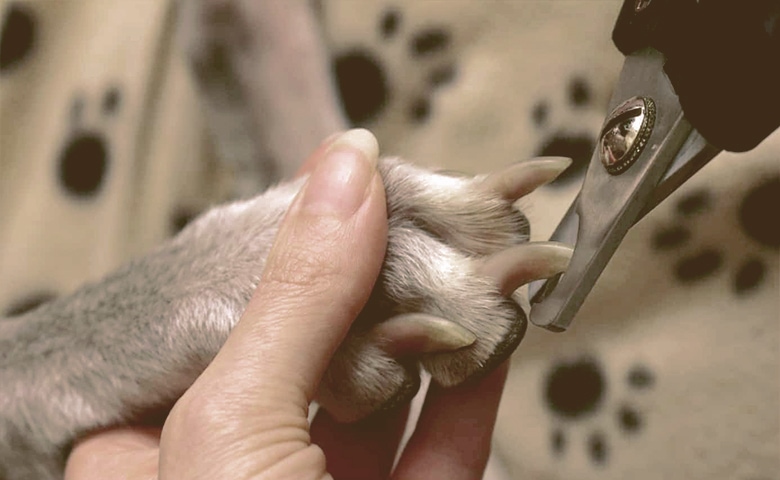
There are not many steps to cutting a dog’s nails. However, there are a few tips to keep in mind, which you will learn after following these simple steps to trimming a large dog’s nails:
- Step One – Decide which clipper should be used
- Scissors style for nails that are curled around and overgrown
- Guillotine style for short nails needing a trim and those that are trimmed often
- The grinding style for both types to work them down to the proper length
- Step Two – Trim the nail at a 45-degree angle.
- Make many minor cuts versus one more significant cut
- Many small cuts are easier to do, so you don’t accidentally cut the nail quick
- Step Three – Check after every cut to see how deep the cuts are going.
- This ensures that you are not going to cut too deeply
- When you see the lighter curved tissue towards the bottom part of the nail, stop cutting.
- Any further cuts could lead to cutting into the quick
- Step Four – Check for any loose or cracked pieces.
- File down any pieces that could potentially get caught on something and cause the dog harm.
- This is when a grinder comes in handy as you can quickly smooth out the nails
Clipping a dog’s nails is that easy. Follow these four simple steps, and your dogs’ nails will be cut appropriately. There are more in-depth tips and tricks you will learn further down the article, but these are the basic steps.
Other resources that you may be interested in:
- The Best Harness for a French Bulldog: Everything You Need To Know
- English Bulldog Pitbull Mix: The Ultimate Guide
How Far Back Do You Clip A Dog’s Nails
There can be quite a few things to take into consideration depending on a few different factors:
- How long the nails are
- How long they have grown out
- The color of the dogs’ nails
If your dogs’ nails have not been cut in a while and are curved, you will need to take some time to cut them slowly. If they are longer nails, the blood supply is also longer. As nails grow, the blood supply extends to stay near the tip of the nail. It grows and recedes as the nail length changes.
This is why when the nails are longer, you will need to clip the nails a little bit at a time. Wait a few days as the blood flow will slowly recede. Every few days, you can trim the nails again. Eventually, the blood flow will have receded to where it should be. The nails will also be short enough that they do not hit the ground when your dog walks.
What Is The Quick?
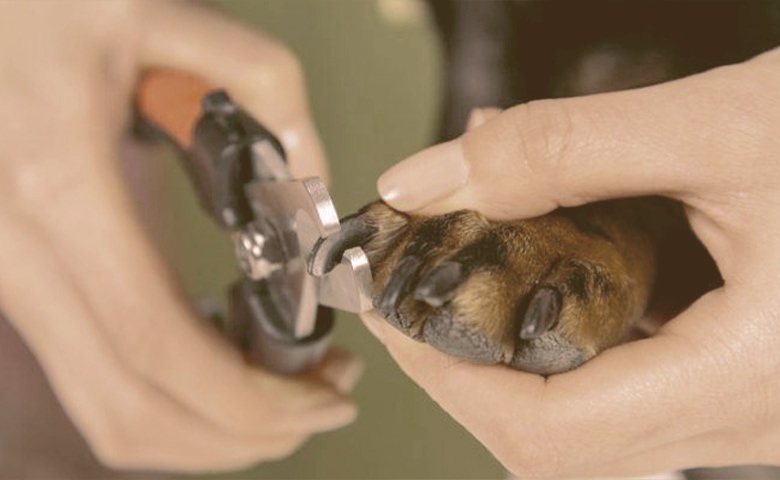
If you are not familiar with the quick, it is simply a term referring to the blood supply and nerves at the end of the dog’s nail. If your dog has light-colored nails, you will be able to see the quick, but unfortunately for dogs with darker nails, it’s more of a guessing game. In dogs with light-colored nails, the quick can easily be seen. Look for the pink-colored center of the nail.
It is essential to mention that the quick will be pink in light-colored nails while the nail itself is white. If your dog has darker colored nails, the quick is black or brown along with the nail. This can be a little confusing when clipping your dogs’ nails and why it’s best to go slow. Only clip a little bit at a time.
What Happens If You Cut Too Far?
The quick can easily be nicked. It will be painful to the dog and can bleed depending on how deep it was cut. The blood should stop within ten minutes. If the quick is cut, it will also take around three to seven days to heal. If the bleeding can’t be controlled, you can use a styptic powder or pencil.
Both can be found at pet stores, online, and at some pharmacies. Styptic powder is made from alum and sulfate salts that stop bleeding. They sting when applied, so it is up to you to decide if it is worth the pain it could cause. If the bleeding slows after a few minutes or stops, there is no need to put your dog through it.
They only sting as you apply it, but if you don’t need to, then don’t use it. It will make your dog afraid of having its nails clipped, as it will remember the pain that goes along with nail clippings. A bleeding nail that won’t stop after ten minutes and use styptic powder or pencil needs immediate attention from your dog’s vet.
How Often Should You Trim A Dog’s Nails?
As mentioned above, dogs’ nails that are left to grow too long can become problematic. It is a good idea to have a nice routine when talking about cutting your dog’s nails. To keep your dog’s nails at their best, you should clip their nails every two weeks at the longest. This will help the quick recede into your dogs’ nails, and clipping will end up being a breeze.
How Do You Cut An Uncooperative Large Dog’s Nails?
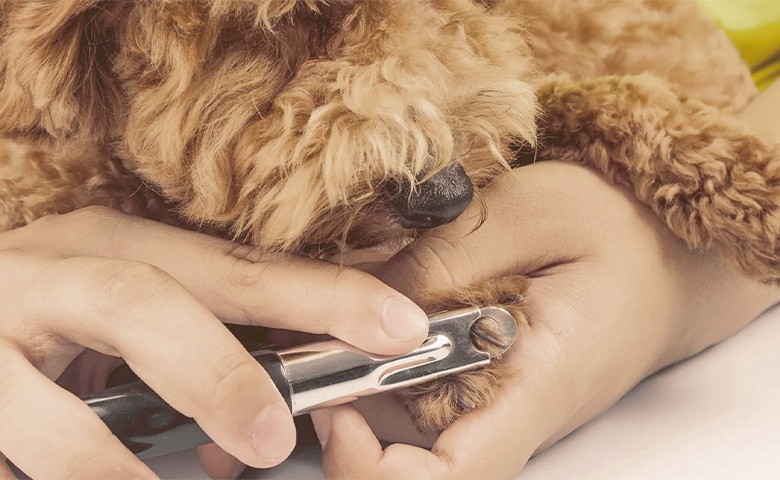
It can be a little tricky to cut a dog’s nails when they fully cooperate. When you add in the fact that they are large dogs, it gets a little more complicated. Then when you add a dog who is very scared to get its nails cut or worried about new things, you have a problem.
Some groomers won’t clip dogs that have a lot of issues with nail clippings. This is for a good reason. If your dog is already stressed out, adding a stranger into the mix can make it a traumatic day for your four-legged friend. They also don’t want to risk injury to themselves or the dog if it tries to get away.
Keeping Your Dog Comfortable
The first and most crucial step is to keep your dog as comfortable as you can. There are many ways you can do this. You know your dog and what will work best, but a few things you could do are:
- Bath them (if they like them) to help them relax
- Have them in a quiet and calm space away from unwanted distractions that could make them pull away or jump.
- Hold the dog, yes, that’s right, hold your large dog, cuddle them
- Pet your dog and talk calmly
You don’t want to yell or force the dog. It will remember and tie the yelling in with the nail clippings ruining it for them.
Let Them Get Familiar With The Tools
Next, you should let your dog sniff and see your nail clipping tool of choice. First, show your furry friend the tools with them not turned on (if they’re electric tools). Say happy words and let them investigate the tools. You can then try and turn them on so they can get used to the sound. That sound is one massive reason why dogs get scared.
A weird unknown noise is near them, and they don’t like it. After a few days of showing them the tools with the tools off and on, your dog should let you get near them with the tools. They won’t see the tool as a threat anymore. Most importantly, you should be patient.
Be Patient – Take It Slow
It can be hard to stay calm and have patience when you know your dog needs its nails trimmed. Take it slow and take breaks if needed. Some larger dogs will only let you do one paw a day, and that’s ok. If they let you trim them all in one day, then go for it. You will know when your dog has had enough.
Don’t Stress Yourself Out – Your Dog Will Sense It
You may try not to show it, but your dog will know it if you are stressed. A family pet can sense when tensions are high and will then become stressed themselves. Only cut your dog’s nails if you know what you are doing. As long as you know what you are doing and safely restrain your dog using the techniques below, you will not harm your dog.
Take a breath and trust yourself to handle trimming your dogs’ nails. If you flinch, jump, or stress out, your dog will do the same. Go in confidently. If you can’t, it is a good idea to hire a professional to clip your dog’s nails. Some vet offices will also take on finicky dogs.
Treats
Almost everything in life can be fixed with a treat. If your dog has a favorite treat, it’s a good idea to have it on hand. If there is a particular food that they love, like peanut butter, you could put some on a plate for them. This can help distract them from what you are doing while they eat the peanut butter.
Pro Tip: Make sure the peanut butter you give your furbaby doesn’t have any xylitol in the list of ingredients. Xylitol is toxic to dogs, and some peanut butters use it as a preservative.
This could also be the one time you let them indulge in a small serving of their favorite table food. While vets do not typically recommend giving dogs table food, if it makes your dog feel comfortable, try it. Dogs also love chicken and veggies, which are also really great for them.
How To Restrain A Large Dog For Nail Clipping
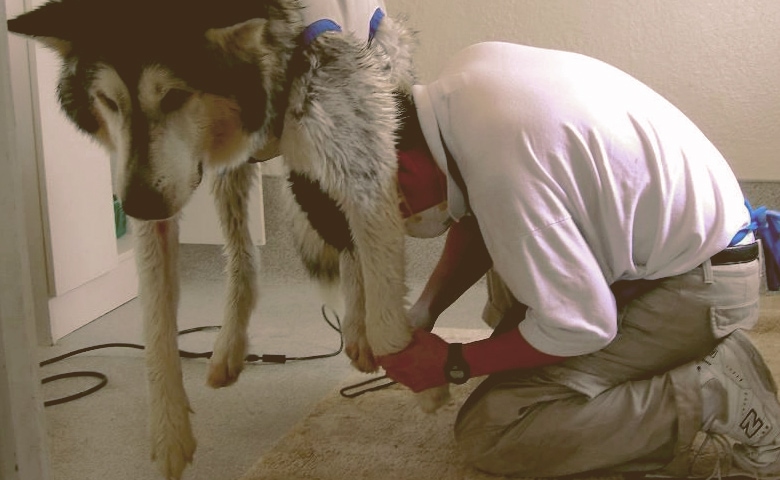
One of the biggest struggles you can have with large dogs is cutting nails. Cutting nails is right behind trying to get a calf-sized dog into a bathtub. It is a good idea to have someone the dog trusts help you when clipping its nails. It is just as important not to have someone that the dog may be skittish around.
Trying to wrestle a large dog that doesn’t want its nails clipped can be a nightmare. You could end up scratched or even bit. Your dog could end up ripping their paw away mid-cut, causing a lot of damage. In this section, you will find every tip, trick, and tool you can have in your corner before clipping your dogs’ nails.
Using Tools To Safely Restrain Your Dog
There are a ton of different-sized grooming hammocks on the market. The MRRY dog hammock can hold even larger dogs. The hammocks are typically made of a towel type of material. They safely support the dog’s weight while you can clip their nails without any risk of them taking off on you.
You simply place your dog’s paw through the holes and pull the material around the dog.
The SHELANDY pro grooming arm is an excellent example of what to use. It clips to a table and has an adjustable arm, even for larger dogs. It has two large nylon loops for the dog’s back legs and a smaller nylon loop for their head.
This helps to secure the dog in an upright position while you are clipping its nails. It won’t fully restrain your pup, but it does help quite a bit for the dog which may want to walk away or try to sit. It is perfect for dogs that are only a little anxious during nail clippings.
Tips And Tricks To Restrain A Large Dog
If you do not have a grooming table or anything on hand, you may use things around your home. Keeping your dog comfortable while restrained is the primary goal, and you may be surprised at what you can use to do so:
- MakeShift Grooming Table – If you have a sturdy table and a rubber kitchen/bath mat, that will work together.
- The table gets the dog in the air so you can reach your dog’s paws easier.
- The mat makes a stable surface for your dog, so it isn’t slipping or sliding around.
- Collar And Leash – It may seem a little silly, but using your dogs’ collar and leash will work in a pinch.
- You simply put their leash on like you usually would, then tie the end of it to secure their head.
- This will stop them from running.
- Throw in a nice walk afterward, and they may put two and two together that clipping equals walks.
- Blanket Or Sheet – You can lay your dog on its side, even in the dog bed.
- While it is lying there, you can comfort it, give belly rubs, and clip the nails while relaxing.
- You may need a partner for this one; one loves the dog while the other clips the nails.
- Cuddling – As you read above, you can get your dog on your lap in a comfortable position.
- Bigger dogs sometimes do not know their size and love to get right onto your lap. Use this to your advantage.
- Let your dog snuggle on your lap, on the couch, or on your bed.
- This is a straightforward way to soothe your dog and try to clip their nails.
- Treats – It is worth mentioning again. Treats are so simple and very useful when needing a dog to do what you say.
- Some dogs are stubborn and don’t want to listen, and you show them a treat, and all of that can change.
As both of you get comfortable with nail clippings, it will become much more manageable. Pretty soon:
- Your dog will not fight or fear the clippers
- Both of you will be much more relaxed
- The nails will be easier to be clipped
- The risk of cutting the quick will be lower
Different Tools To Use When Cutting A Dog’s Nails
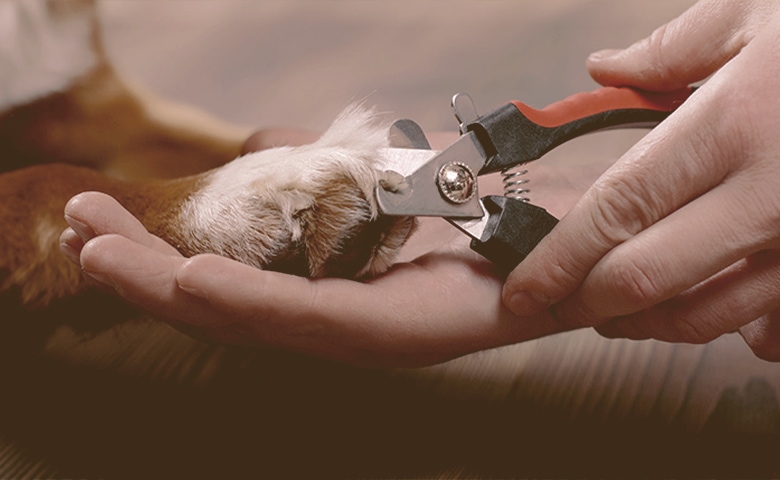
Now that you know how to cut your dogs’ nails and restrain them let’s look at some of the top nail clipping tools. There are three main types of dog nail clippers on the market. They are used for different situations.
In this section, you will learn how each tool works and when to use it.
Grinding Tools
These are growing immensely popular among pet owners as they fear they may clip too much. With a grinding tool, you already know it simply grinds and files away from the nail a little at a time. When using a grinding tool, some noise may be frightening to a dog. It is essential to take that into consideration. If your dog panics when the traditional clippers grab onto their nail, the grinder is a good choice.
Grinding tools have a small rotating head with sandpaper or a nail file type of material on it. They are remarkably similar to those used in nail salons for humans. Using the friction of the nail file in motion, the tool safely grinds away your dogs’ nails. They are quite easy to use. Grinders are also less likely to go too deep as you are controlling it fully.
When you use other cutting style clippers, you could accidentally cut too deep, while the grinding will only remove small layers at a time. They are also perfect for nails that are cracked or have sharp edges. The nail will be smooth and less likely to catch on to something injuring your dog. A great grinder is the Casfuy Nail Grinder.
Guillotine Nail Clippers
These are also extremely popular among pet owners. They have a small circular opening into which your dog’s nail is placed. When the handle is squeezed, a blade comes down and cuts the nail off. These are typically recommended for thinner nails on medium-sized or small dogs. They can’t always handle the thicker nails on large dogs.
While they do make a quick clean cut there are some things to take into consideration:
- The blade on the guillotine needs to be replaced, whereas the other types don’t need this
- Some dogs panic when their nails are placed in the small hole, causing them to pull away
- If your dog pulls away, they may shift their nails. This is a problem because you can easily cut too deep if this happens
- May cause a break in the nail that can snag on different materials and split the nail
- It cannot cut through large nails, and it may get halfway through and get stuck
It is best not to use this style for large dogs with thicker nails and stick to the scissors or grinding tool. You could also use a combination of both to tackle thicker nails; just stay clear of the guillotine-style tools.
To that point, let us discuss the scissors.
Scissors Nail Clippers
These have been around for years and are used in many homes around the world to clip different pets’ nails. They have a lot of force behind them, making for an exceptionally clean and quick cut. They don’t have a hole like a guillotine and instead are shaped like standard scissors with one exception. The blades are curved, so they fit nicely around the dog’s nail.
This stops the nail from shifting or rolling. You don’t want your dog’s nail being tugged. It will make your fur baby highly uncomfortable and potentially pull away ripping the nail. These are all reasons they make such great at-home nail clippers. It is harder to mess up and injure your four-legged friend. Here is a nice pair of scissors by Safari.
Keeping Your Dog’s Nails Healthy
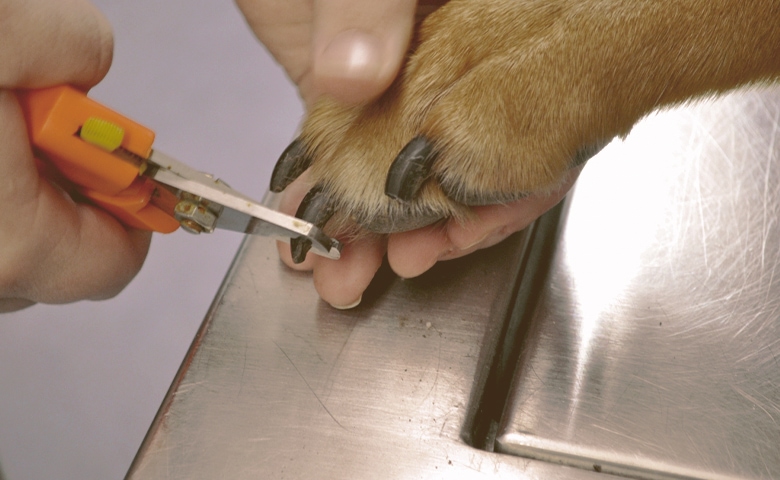
Aside from keeping your dogs’ nails clipped, it would help if you also tried to keep them healthy. It is straightforward for dogs’ nails to overgrow, become cracked, or irritated. Keeping them trimmed is as essential as keeping the tools you are using in good shape.
Trim Often
It has been mentioned a few times but worth mentioning again. Trim your dog’s nails every two weeks at least. There is no problem with trimming them every week. As you trim them frequently, the quick recedes back into the base of the nail. This makes them relatively easy to cut as the blood supply and nerves will no longer be all the way throughout the nail.
A great tip is to use the scissors on your larger dogs’ nails then the grinder to smooth any edges. This means your dog’s nails won’t snag on anything. You also won’t have to worry about your dogs’ sharp nails accidentally scratching you or others.
Keep Blades Sharp
It may not cross your mind, but the scissors, guillotine, and grinders all need to have maintenance performed regularly. The grinders will become smooth as you use them, losing their grit. They are quite easy to change out and usually come with extra heads. If they don’t come with extra head attachments, you can usually find them wherever the tools were sold.
The guillotines will need the blade replaced regularly, and the scissors simply need sharpened. If the blades are not sharp, they won’t make a complete cut through the dog’s nail and could become caught in their nail. A smooth grinder won’t injure them; it just will buff the nail compared to grinding it away.
Keep Units Fully Charged – Replace Batteries
Just like you need to keep everything sharp and new, you also should charge the grinder or replace the batteries often. Low battery power tends to slow the rate at which it spins. This won’t harm the dog, but it will not grind away the nails as it should.
Check Tools Before Use
If you have replaced blades and batteries and sharpened your tools, the next important step is to give them a once-over. Always make sure to check the clippers before using them. Look for cracks in the blades, missing screws, and anything that looks off.
Even the best tools can have wear and tear on them.
Safely Cutting A Large Dog’s Nails
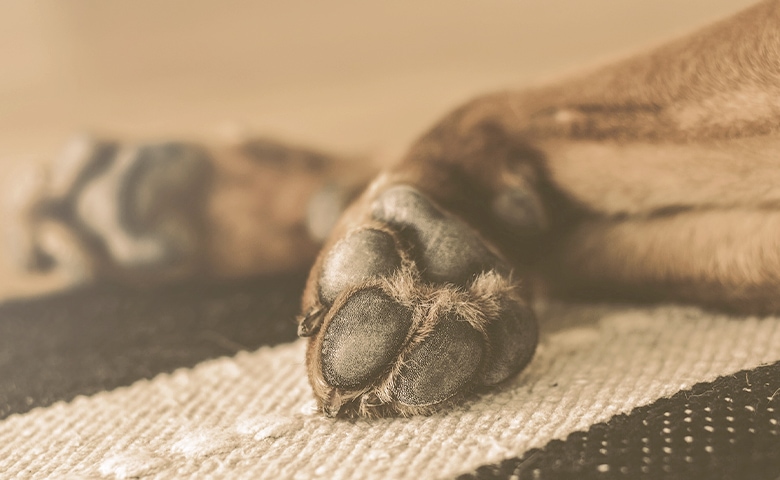
With this guide, you will now be able to cut your large dog’s nails without being injured yourself. Not only will you be able to cut their nails properly but also be able to restrain them safely.
Remember to have confidence, and at the end of the day, if you can’t handle it (like many other pet owners), you can call a professional.
Sources
Daily Med – Styptic Powder
American Kennel Club – Trimming Dog’s Nails
K9 Of Mine – Clipping Tools

